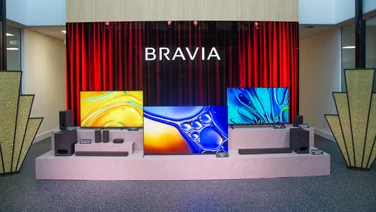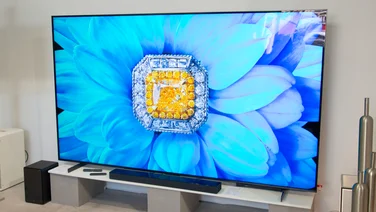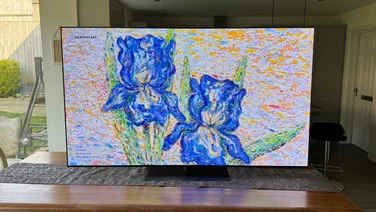To help us provide you with free impartial advice, we may earn a commission if you buy through links on our site. Learn more

- Impressive black level
- Wide viewing angle
- Super-low input lag
- No Dolby Vision HDR
- Colour accuracy is worse than rival brands
Update: Samsung's Q80R has been replaced by the Samsung Q90T (2020)
The Q80R reviewed here has been discontinued and is no longer available to buy from online retailers. It has been succeeded by the Samsung Q90T, a new 2020 4K TV that's almost identical to the Samsung Q80R in terms of features, and you can buy it directly from Samsung right now.
Samsung
Our original review continues below:
Samsung front-loaded last year’s QLED range to a frightening extent. The expensive range-toppers were groaning under the weight of their own extensive specifications, but the QLED TVs further down the range got pretty humdrum pretty quickly.
That’s changed. The current Q90R flagships are still packing every nicety imaginable – but their lesser stablemates now enjoy a few more goodies. In fact, the Q80R might be the sweet-spot of the entire QLED line-up. This looks to be where the balance between features, value for money and performance is perfectly poised.
At this level, however, value for money is relative. £1,700 (or £2,000, if you’re blase enough to buy direct from Samsung) for a 55in TV is not an inconsiderable sum, so is making the £900-or-so saving over a same-size Q90R the wise choice or a false economy?
Samsung Q80R (QE55Q80R) review: What you need to know
The Samsung QE55Q80R employs a 4K VA-type panel and uses full-array local dimming (FALD) zones for its backlighting. It benefits from Samsung’s class-leading user interface – its on-screen menus manage to be comprehensive without being busy or intimidating. There’s HDR support for HLG, HDR10 and HDR10+, but Dolby Vision is a notable absentee.
Compared to the step-up Q90R, the Q80R lacks the external One Connect box and downgrades the FALD zones from 480 down to just 50. Which begs the question: shouldn’t you just throw caution to the wind and buy a Q90R instead?
Well, if you value neatness above all else, and are intending to wall mount your TV, you may want to consider digging deep into that wallet and finding the extra cash. It’s impossible to understate how useful the Q90R’s One Connect box and ultra-long optical cable are: you can push all those ugly cables way out of sight without resorting to expensive installations and replastering. And yes, the image quality is a serious step-up, too.
READ NEXT: Samsung Q90R review: The QLED TV we wish we could afford
Whichever model you choose, however, Samsung’s Ultra Viewing Angle technology isn’t just another bit of canny marketing. It provides super-wide viewing angles – often a relative weakness of other LCD-based sets – as well as impressive resistance to reflections. For brighter rooms, and furniture layouts which make it nigh-on impossible to sit directly in front of your TV, the Samsung steals a march on both its OLED– and LCD-based competitors: its image quality simply isn’t as impacted by where you sit, or how bright your room is.
Samsung Q80R (QE55Q80R) review: Price and competition
Not that there’s a dearth of tempting alternatives at this price. The Samsung lines up in direct opposition to some extremely well-regarded OLED alternatives from LG and Philips (to name but two). And that’s before you even consider the LCD rivals which are hot on its heels.
One recent key competitor is the Sony XG95 (read our review here). At around £1,499 for the 55in model, the XG95 trumps the Q80R for colour accuracy, video processing and motion performance – all key victories for the Sony – but it does fall behind its Samsung-branded competitor for viewability in brighter rooms.
Samsung Q80R (QE55Q80R) review: Features and design
For many people, choosing a TV is about more than just image quality. Indeed, a big part of the reason QLED doesn’t have the initial showroom appeal of OLED is its complete lack of that crowd-pleasing OLED slimness – the full-array local dimming backlight adds considerable bulk. As a result, the Q80R is comparatively deep (62mm) and heavy (18.6kg).
It’s very tidily built, though, as the price demands – the bezel is minimal and gently curved, rather than square, at the corners. And it’s supported by a central stand, which is far more welcome than the foot-at-each-end alternative which necessitates a wide surface to stand on. And there’s sufficient space to position a soundbar between the bottom of the screen and the stand.
One of the key differences between this Q80R and the more expensive Q90R is the absence of Samsung’s One Connect box. Instead, the Q80R has all its connections in the chassis of the screen. They run to four HDMI 2.0 sockets, a couple of USBs, an Ethernet input (dual-band Wi-Fi is onboard too), two satellite TV aerial connections and one terrestrial TV aerial socket.

Navigation is either via Samsung’s standard (and rather slapdash) IR remote control, a far less button-heavy Bluetooth handset, Samsung’s clean and stable Smart Things app or (if you want to get tetchy quickly) voice control using Alexa or Google Assistant.
No matter the control route you go down, you’ll be navigating a mercifully clean, yet quite comprehensive, Tizen GUI. It’s swift in operation, covers everything from fine-tuning picture quality to streaming service selection in a logical fashion, and doesn’t swamp the entire screen as it does so.
Samsung Q80R (QE55Q80R) review: Performance
In one important respect, the Q80R is a big improvement over last year’s equivalent QLEDs – off-axis performance. Samsung’ Ultra Viewing Angle technology is basically an extra panel layer to prevent backlight leakage and focus light more effectively – and it works well. Sit even radically off-axis and images still maintain most of their integrity.
Sit in the sweet-spot, though, and things are generally pretty impressive. With peak white calibrated to 120cd/m2 (or nits, if you prefer) and with ‘Local Dimming’ (there are 50 independently dimmable zones) at ‘Standard’, contrasts are strong. The black level is particularly deep by prevailing LED LCD standards. There are more blooming artefacts and a little more haloing compared with the Q90R (not surprising given its 480 dimming zones), but the Q80R compares very favourably with Sony’s LED LCD competitors – even if the letterbox bars are very dark grey rather than black.
HDR content is an obvious beneficiary of this talent. Measured peak brightness is 1100 nits, making for vivid, vibrant and convincing images – even if that figure is down on Samsung’s claims.
DCI-P3 coverage is a very acceptable 95%, though posterisation in bright highlights makes switching ‘Colour Space’ from ‘Auto’ to ‘Native’ necessary – even though it results in reduced colour accuracy. Overall colour accuracy, in fact, compares unfavourably to some competing brands. Disappointingly, it’s not possible to perform CalMAN Autocal to remedy the problem as the European version of the Q80R lacks an EX-Link socket – something which is present on the US version.

Screen uniformity is impressive by LCD standards, though. The Samsung is very clean, with negligible dirty-screen effect – but there’s just a sliver of colour tinting along the borders that’s visible on full-field grey slides.
For content upscaling, the Q80R is solid rather than spectacular. You’ll never mistake Full HD content for native 4K images – the drop-off in contrast and brightness is too pronounced. Upscaling is low-noise, mind you, and the results are never less than watchable.
The Samsung Q80R makes a great deal of sense for gamers too. Its lag of 16ms (in 1080p SDR and 4K HDR modes) is one of the lowest around and makes the Q80R one of the most responsive TVs on the market.
As far as sound is concerned, the Samsung fights valiantly against the usual flatscreen TV cliches of thin, reedy audio. It’s quite a robust listen, with what might even pass for actual dynamic headroom. It almost doesn’t need saying, though, that a 55in screen at this sort of money really deserves a soundbar at the very least. That’s what that gap between the screen and the stand is for, after all.
Samsung Q80R (QE55Q80R) review: Verdict
As long as ultimate slimness isn’t the be-all and end-all of your TV selection process, the Q80R deserves your serious consideration. The punchy image quality, super-wide viewing angles and anti-reflective filter are a huge boon for daytime TV watching – and especially so in brighter rooms. All told, this QLED TV strikes a canny balance between performance and price.







